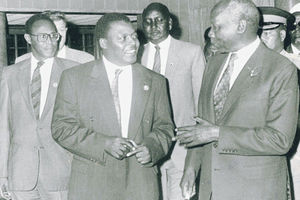Premium
Money and youth schemes Kanu crafted to keep power

Mr Cyrus Jirongo who was the chairman of YK'92. On November 12, 1992, the Daily Nation unearthed how NSSF had purchased two properties at Sh1.2 billion from Sololo Outlets, a company associated with Jirongo. PHOTO/FILE.
What you need to know:
- Kenya’s return to competitive politics in 1991 presented challenges to the ruling party, Kanu, and President Moi.
- The party was threatened by the opposition, which included Ford Kenya, Ford Asili, and the Democratic Party.
- Some of the politicians were members of the Youth for Kanu ’92 (YK’92) lobby group.
- On November 12, 1992, the Daily Nation unearthed how NSSF had purchased two properties at Sh1.2 billion from Sololo Outlets, a company associated with Jirongo.
Kenya’s return to competitive politics in 1991 presented challenges to the ruling party, Kanu, and President Moi.
The scheme the party came up with to battle the opposition plunged the country into economic doldrums.
The repeal of Section 2A of the Constitution led to the December 1992 General Election, in which for the first time in many years, Kanu’s monopoly on power was challenged.
The party was threatened by the opposition, which included Ford Kenya, Ford Asili, and the Democratic Party.
In the end, Moi managed to hang on to the presidency in the face of fierce competition, but at a great cost to the economy.
According to Joel Barkan in his 1993 paper, Kenya: Lessons from a Flawed Election, Kanu devised multiple strategies to win the election. One was to print money to buy voters.
Businessman Kamlesh Pattni donated over Sh11.2 billion through his company, Goldenberg International.
The other source of funding was the National Social Security Fund (NSSF).
The NSSF would use money invested by workers to buy properties at inflated prices, especially those previously owned by politicians.
YK'92
Some of the politicians were members of the Youth for Kanu ’92 (YK’92) lobby group.
Among the YK’92 members were chairman Cyrus Jirongo, then 31, and William Ruto, the current deputy president.
On November 12, 1992, the Daily Nation unearthed how NSSF had purchased two properties at Sh1.2 billion from Sololo Outlets, a company associated with Jirongo.
The estimated value of the properties at the time was Sh66 million. The remaining Sh1.13 billion went to Kanu’s campaign kitty.
According to Charles Hornsby and David Throup in their 1998 book, Multi-Party Politics in Kenya, Jirongo was to use the money to develop the South B housing project, under which Sololo Outlets was constructing some 500 housing units.
NSSF paid Sololo Outlets Sh 2.5 billion through Post Bank Credit, but ended up paying Sh900 million only. The bank gave the remaining Sh 1.6 billion to Kanu.
The opposition reasoned that since the price of the NSSF’s new building kept rising, from the initial Sh468 million to over Sh3 billion as the construction dragged, the money was being used to fund the Kanu campaign.
The money would move from NSSF to the contractors of the building, Mugoya Construction, a company associated with Moi.
Hornsby and Throup argue that between January and November 1992, Kanu and President Moi spent over Sh73.5 trillion, directly and through proxies such as YK’92 and other youth groups.
According to Prof Peter Kagwanja in his 2005 paper, Power to Uhuru, YK’92 carried out their purpose by heckling and intimidating the opposition during political gatherings and vote buying.
Group employed Kalenjin warriors
For instance, they warned the opposition against campaigning in the rural areas of Kenya or “Kanu zones”.
To reinforce this policy, the group employed Kalenjin warriors. The warriors attacked the Luhya, Luo, and Kikuyu people in the Rift Valley.
The YK’92 had the backing of the provincial administration and police, which they used to campaign in opposition strongholds.
Opposition leaders such as Mwai Kibaki of DP, Jaramogi Oginga of FORD-Kenya, and Kenneth Matiba of FORD-Asili tried to fight back, but they could not match the resources deployed by YK’92.
The state broadcaster, KBC, was used to air the “benefits” of Moi’s presidency. YK’92 disbursed funds to youths and women.
The opposition was at a disadvantage because it did not have the resources to counter such a show, neither could it hold rallies in so-called Kanu zones.
As elections neared, YK’92 also became a channel for distributing the newly printed Sh500 note, which became informally known as “Jirongo”.
However, according to Charles Hornsby in his 2013 book, Kenya: A History Since Independence, YK’92 had campaign groups in most districts and more than 30 smaller organisations established to campaign for Kanu, with the promise of sharing the country’s wealth if they could effectively counter the opposition.
The organisations included Operation Moi Wins (OMW), Operation Toroitich 2000, National Organisations of Kanu Youth, Women in Action, Luo Elders for Kanu, and Intellectual Task-Force for the Re-election of Moi.
The chairman of OMW was Evans Ondieki.
The purpose of OMW was to stem the collapse of support for Kanu and Moi’s re-election in the Luo community and in Eastern Province.
According to Hornsby and Throup, OMW was not short of cash, just like YK’92.
These youth wings were widely credited with Kanu’s success in the December 29, 1992 election.
President Moi won with 36 per cent of the national vote against his three rivals: Kibaki, Odinga, and Matiba.




